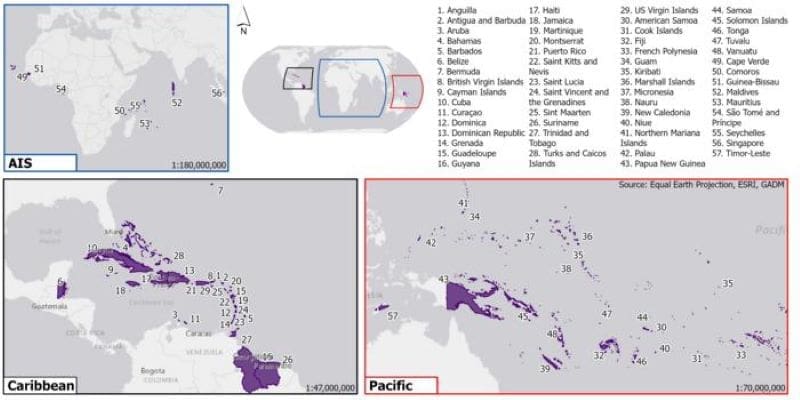New research reveals that some of the world’s smallest nations, which contribute the least to climate change, are facing increasingly severe flooding risks. Residents of Small Island Developing States (SIDS) across the Pacific, Caribbean, Indian Ocean, and South China Sea are experiencing rising flood exposure, with numbers expected to grow as climate pressures intensify.
Published in Environmental Research Letters, the study finds that nearly one in five people, or 8.5 million residents across SIDS, are now at risk of flooding from both coastal and inland sources. This rate triples in countries like the Bahamas, Guyana, and Tuvalu, where more than 60% of the population faces regular flood exposure.
Lead author Leanne Archer, a Research Associate at the University of Bristol’s Cabot Institute for the Environment, highlights: “Flooding is now an alarming real-world threat for so many people globally. This study demonstrates that the often-overlooked Small Island Developing States are already subject to a disproportionate level of flood exposure, despite contributing the least to climate change.”

Amidst recent record-breaking rainfall across regions like Valencia, Spain, these findings underscore the urgent need for better flood risk management and adaptation strategies. Utilizing a high-resolution model developed with water risk intelligence firm Fathom, the study mapped flood risks for all 57 SIDS, capturing the role of both coastal and inland flooding – a major risk factor often unaccounted for in previous studies.
Archer, who conducted the research for her PhD, notes that: “Previous studies have only focused on coastal flooding, representing a significant underestimation of exposure. This is also the very first time a comprehensive picture of flood risk has been mapped across all 57 Small Island Developing States.”
The study’s projections reveal that even if global warming is limited to 1.5°C by 2100, 21% of SIDS populations could still be at risk of flooding. In a scenario exceeding 4°C, this figure could climb to nearly a quarter of the population. While risks will vary by region, some nations – including Belize, the Turks and Caicos Islands, and the Maldives – are anticipated to remain at the forefront of flood vulnerability.
Paul Bates, co-author and Professor of Hydrology at the University of Bristol, emphasizes the study’s urgency for policymakers, explaining that: “This study fills an important gap in research, including direct measures of flood hazard and exposure which are essential to adequately reduce loss and damage from flooding in the Small Island Developing States.”
He urges policymakers worldwide to act decisively, stating: “The results are a timely warning to the world’s political leaders and policy makers that global commitments to significantly reduce carbon emissions must be backed up by action, in order to reduce potential loss and damage from flooding in Small Island Developing States, which contribute least to harmful carbon emissions.”
The study reveals that inland flooding, rather than coastal flooding, accounts for 81% of flood exposure across SIDS, a critical factor often overlooked in climate adaptation planning.
Populations in SIDS are predominantly concentrated along coastlines, making them particularly susceptible to both coastal and inland flood risks. This research highlights an urgent need for adaptation measures tailored to both coastal and inland threats as well as disaster preparedness programs.
SIDS face unique vulnerabilities, not only due to their geography but also because of limited resources for climate adaptation and mitigation. Increasingly severe rainfall, sea level rise, and more extreme storm surges fueled by climate change compound these risks, highlighting the need for comprehensive and equitable climate resilience efforts.
Conducted in partnership with the University of Southampton, this study offers important insights into the impacts of climate change on populations who have contributed the least to global emissions – a key focus of the Cabot Institute’s research on climate resilience and environmental justice.
Journal Reference:
Leanne Archer.Jeffrey Neal, Paul Bates et al., ‘Population exposure to flooding in Small Island Developing States under climate change’, Environmental Research Letters 19, 124020 (2024). DOI: 10.1088/1748-9326/ad78eb
Article Source:
Press Release/Material by University of Bristol
Featured image credit: mrsiraphol | Freepik




